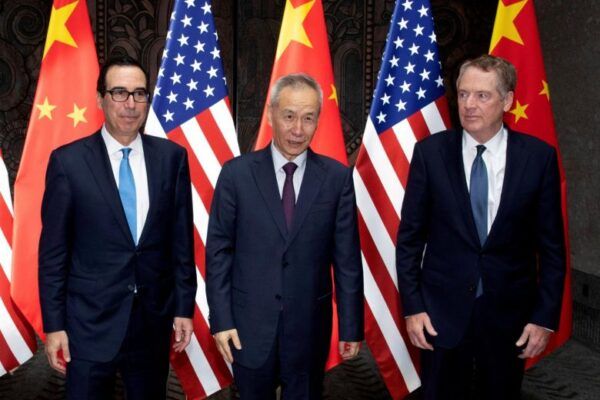
Although China and the US reached a temporary trade agreement in Washington on October 11, this does not mark a cessation of the conflict between the two imperialist powers which has raged for 16 months. The deal reached, which postpones proposed US tariff increases to 30%, in return for China making bigger purchases of some US farm goods, is anything other than “very substantial” as president Trump characteristically proclaimed.
There is nothing in this deal that could not have been achieved a year ago, without the punishing economic costs both sides have inflicted upon each other. The existing tariffs of both sides remain at the level of 25%, while further tariffs threatened by Trump to take effect on December 15 are not included under the terms of this truce.
Ironically, in the US political system, Trump has now become a “moderate” towards China. On October 1, when the Chinese dictatorship staged a grandiose 70th anniversary military parade, Trump sent a tweet congratulating Xi Jinping, but said nothing about the even more brutal repression of the Hong Kong police that day (for the first time a young protester was shot with live ammunition). The president therefore came under fire from anti-China hawks in both the Republican and Democratic parties.
While the extremely limited trade ‘ceasefire’ reached in Washington may temporarily soothe nervous stock markets, it is clear that the main direction of the Sino-US conflict is towards escalation. We also know that previous temporary truces between the US and Chinese regimes have broken down, sometimes within days, as was the case with the deal reached at the Osaka G20 meeting in June. Significantly, while Trump hails the October 11 agreement as a breakthrough, there is no news of a “deal” in Chinese media (state-controlled), only reports of “progress” in the negotiations. The scope for de-escalation of the conflict looks increasingly fragile and limited.
The US president threatened in September to de-list Chinese companies from the US stock market. While this has not been acted upon, it is just one of many measures Washington is considering to block China’s investments and limit its access to US capital markets. The tech war, which is much more serious in terms of its longer term implications for the global economy, continues to escalate with the US side expanding its ‘black list’ of Chinese tech companies that could face sanctions.
Both sides desperate
On October 7, just days before the Washington talks got underway, the US Commerce Department put 28 Chinese public security bureaus and companies on a trade blacklist citing Beijing’s treatment of Uighur Muslims and other Muslim ethnic minorities in Xinjiang. The fact that this action, an extreme provocation in the eyes of Xi’s regime, did not shipwreck the talks in Washington is a sign that both sides are desperate to achieve at least a temporary and partial de-escalation of the conflict, to prevent even greater economic disruption. Bilateral trade between the world’s two largest economies dropped by nearly 14% in the first half of the year compared with the same period in 2018.
For the Chinese regime, this willingness to strike a limited deal, even as the US side threatens further trade and financial penalties, underlines the extreme pressures it faces at home, with a severe economic downturn and rising unrest shown most graphically by an unprecedented summer and autumn of discontent in Hong Kong. The agricultural concessions from Xi’s negotiators are not huge, but by agreeing to this they are partially giving up a weapon they have been using to pressure the US side (targeting farm goods is a favoured weapon of Beijing as seen in other disputes from Taiwanese fruit, bananas from the Philippines and Norwegian salmon).
Trump has been forced to scale back expectations dramatically and is a long way from the comprehensive resetting of US-China trade that he boasted his aggressive policies would achieve. He now welcomes even a minimal trade deal with China to avoid going into the 2020 elections empty handed.
Overthrow capitalism and imperialism
But Trump is no longer fully in control of the process. His anti-China stance has opened a Pandora’s box of powerful and contradictory forces. This is the logic of imperialist capitalism, where a contest between US and Chinese imperialism to decide who rules the planet is inevitable. This can only be prevented by the working class overthrowing capitalism and imperialism through the coming to power of real socialist governments in a number of countries, paving the way for international socialism and democratic planning of the world’s resources.
Such are the speed and volatility of global processes that Trump now risks being attacked as “soft on China” by Democrats and Republicans alike. Trump favours making concessions to China over the black-listing of Huawei Technologies, its biggest tech company, but fierce opposition to this from a coalition of forces on both sides of Congress and from the military industrial complex ties his hands. These are the same forces putting pressure on the president to take a tougher line over Hong Kong, not because they give a damn about democratic rights, but because they see Hong Kong as a useful pawn in their ‘containment’ chess game with China.
The CWI explains and warns that the workers’ movement and all movements of the oppressed, such as the youthful democracy protests in Hong Kong, should maintain complete political independence from all the capitalist elites in the current global power struggle.
Trade wars are a way for one gang of capitalist robbers to protect their own ill-gotten gains at the expense of their rivals, while continuing to drive down the rights and livelihoods of the working class and to wreak destruction on an ecosystem that is already close to collapse. Workers urgently need to build their own political alternative to capitalism and right wing nationalism, which is socialist internationalism based on immediate, full democracy and taking the major companies into democratic public ownership. This program is the way forward for the struggles of workers and youth in the US against Trump and his billionaire class and the struggle of the oppressed masses in China against the billionaire CCP dictatorship.

